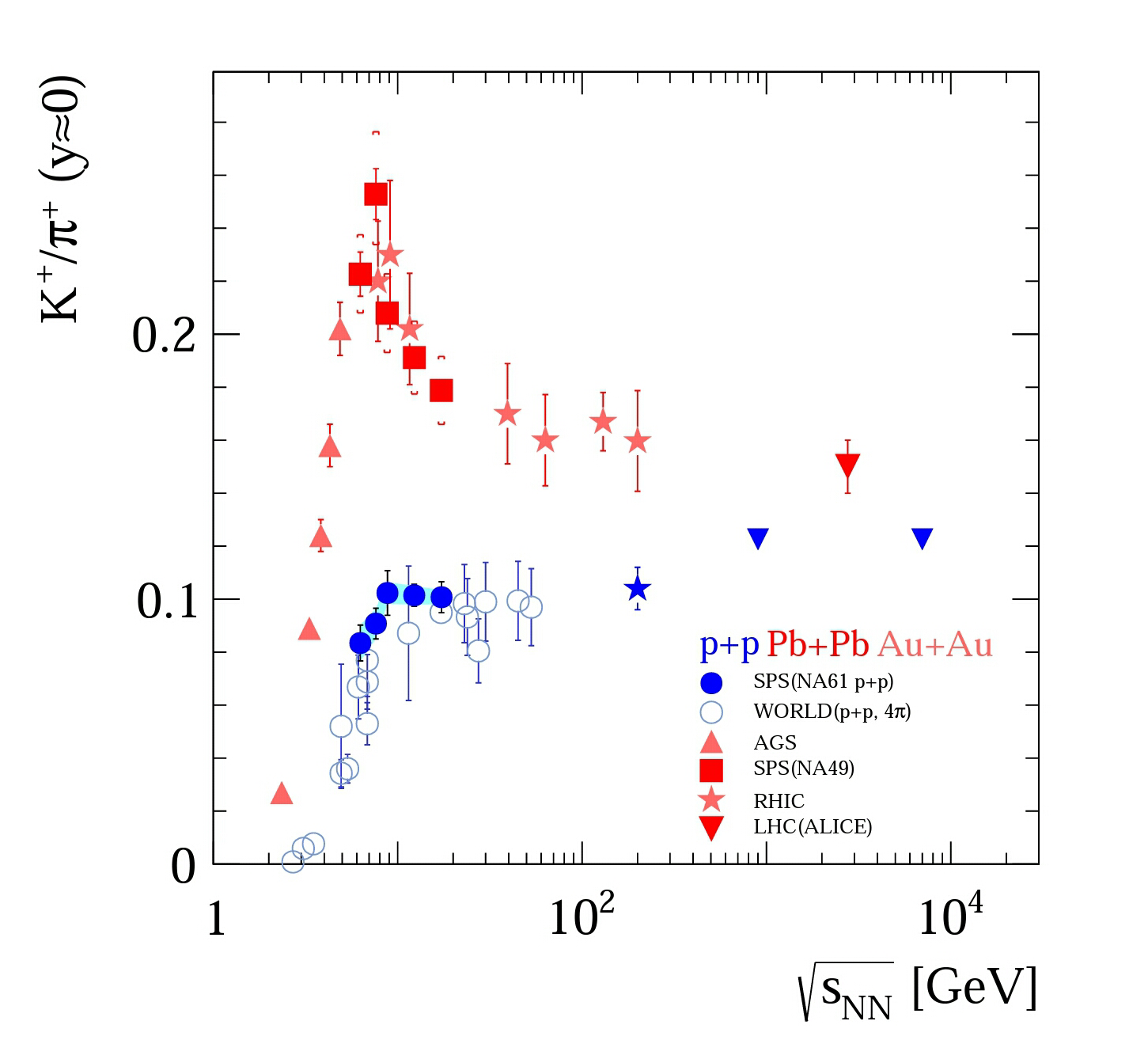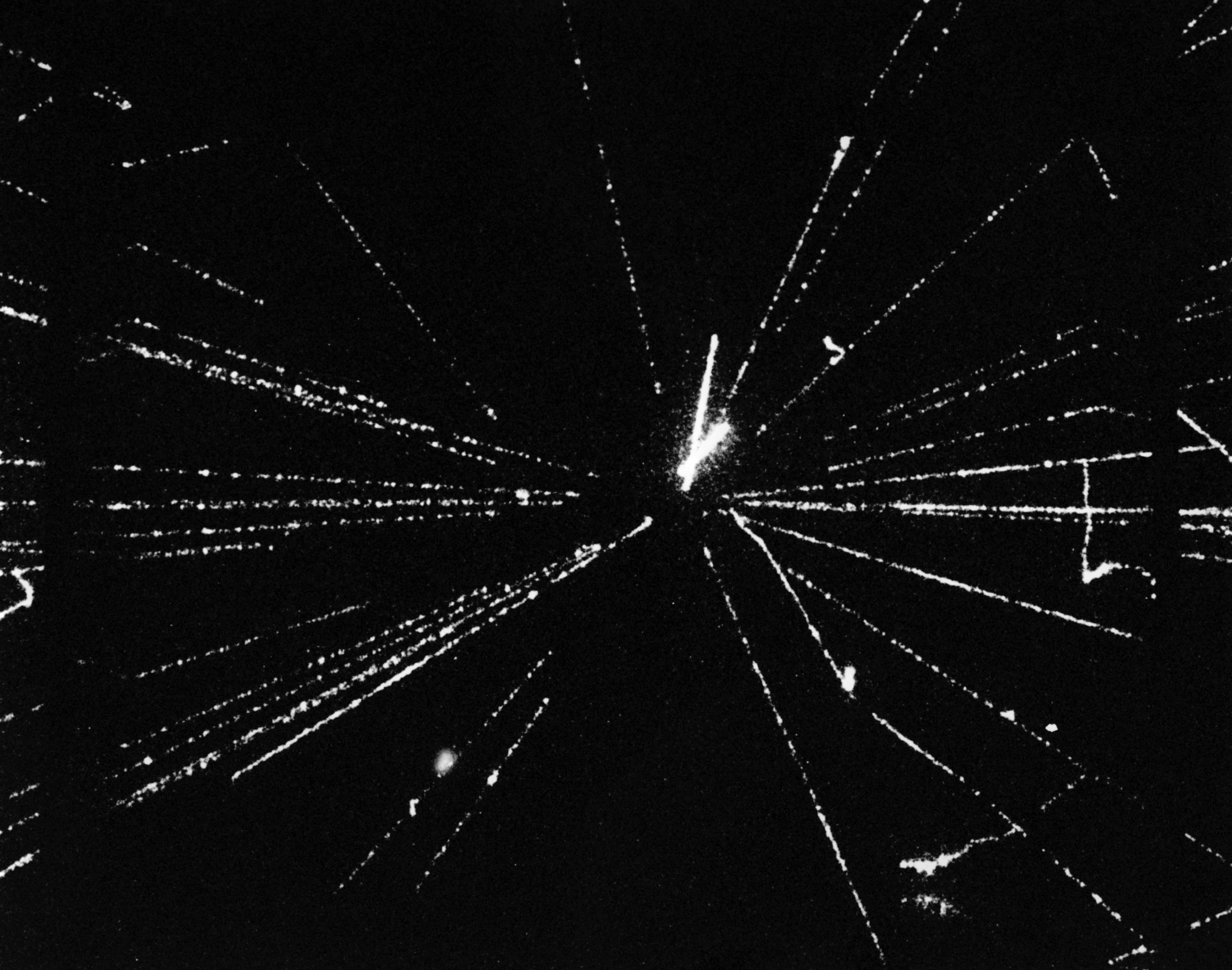|
Onset Of Deconfinement
The onset of deconfinement refers to the beginning of the creation of deconfined states of strongly interacting matter produced in nucleus-nucleus collisions with increasing collision energy (a quark–gluon plasma). The onset of deconfinement was predicted by Marek Gazdzicki and Mark I. Gorenstein to be located in the low energy range of the Super Proton Synchrotron (SPS) at the European Organization for Nuclear Research (CERN). These predictions have been confirmed by the NA49 experiment at the CERN SPS within the energy scan programme. The most famous of these is the "horn" in the ratio of mean multiplicities of positively charged kaons and pions observed in collisions of two lead nuclei at the low energies of the SPS. Strangeness production In particle physics, strangeness ("''S''") is a property of particles, expressed as a quantum number, for describing decay of particles in strong and electromagnetic interactions which occur in a short period of time. The str ... [...More Info...] [...Related Items...] OR: [Wikipedia] [Google] [Baidu] |
Super Proton Synchrotron
The Super Proton Synchrotron (SPS) is a particle accelerator of the synchrotron type at CERN. It is housed in a circular tunnel, in circumference, straddling the border of France and Switzerland near Geneva, Switzerland. History The SPS was designed by a team led by John Adams, director-general of what was then known as Laboratory II. Originally specified as a 300 GeV accelerator, the SPS was actually built to be capable of 400 GeV, an operating energy it achieved on the official commissioning date of 17 June 1976. However, by that time, this energy had been exceeded by Fermilab, which reached an energy of 500 GeV on 14 May of that year. The SPS has been used to accelerate protons and antiprotons, electrons and positrons (for use as the injector for the Large Electron–Positron Collider (LEP)), and heavy ions. From 1981 to 1991, the SPS operated as a hadron (more precisely, proton–antiproton) collider (as such it was called SpS), when its beams provided the data ... [...More Info...] [...Related Items...] OR: [Wikipedia] [Google] [Baidu] |
Atomic Nucleus
The atomic nucleus is the small, dense region consisting of protons and neutrons at the center of an atom, discovered in 1911 by Ernest Rutherford based on the 1909 Geiger–Marsden gold foil experiment. After the discovery of the neutron in 1932, models for a nucleus composed of protons and neutrons were quickly developed by Dmitri Ivanenko and Werner Heisenberg. An atom is composed of a positively charged nucleus, with a cloud of negatively charged electrons surrounding it, bound together by electrostatic force. Almost all of the mass of an atom is located in the nucleus, with a very small contribution from the electron cloud. Protons and neutrons are bound together to form a nucleus by the nuclear force. The diameter of the nucleus is in the range of () for hydrogen (the diameter of a single proton) to about for uranium. These dimensions are much smaller than the diameter of the atom itself (nucleus + electron cloud), by a factor of about 26,634 (uranium atomic radiu ... [...More Info...] [...Related Items...] OR: [Wikipedia] [Google] [Baidu] |
Lead
Lead is a chemical element with the symbol Pb (from the Latin ) and atomic number 82. It is a heavy metal that is denser than most common materials. Lead is soft and malleable, and also has a relatively low melting point. When freshly cut, lead is a shiny gray with a hint of blue. It tarnishes to a dull gray color when exposed to air. Lead has the highest atomic number of any stable element and three of its isotopes are endpoints of major nuclear decay chains of heavier elements. Lead is toxic, even in small amounts, especially to children. Lead is a relatively unreactive post-transition metal. Its weak metallic character is illustrated by its amphoteric nature; lead and lead oxides react with acids and bases, and it tends to form covalent bonds. Compounds of lead are usually found in the +2 oxidation state rather than the +4 state common with lighter members of the carbon group. Exceptions are mostly limited to organolead compounds. Like the lighter members of the ... [...More Info...] [...Related Items...] OR: [Wikipedia] [Google] [Baidu] |
Pion
In particle physics, a pion (or a pi meson, denoted with the Greek letter pi: ) is any of three subatomic particles: , , and . Each pion consists of a quark and an antiquark and is therefore a meson. Pions are the lightest mesons and, more generally, the lightest hadrons. They are unstable, with the charged pions and decaying after a mean lifetime of 26.033 nanoseconds ( seconds), and the neutral pion decaying after a much shorter lifetime of 85 attoseconds ( seconds). Charged pions most often decay into muons and muon neutrinos, while neutral pions generally decay into gamma rays. The exchange of virtual pions, along with vector, rho and omega mesons, provides an explanation for the residual strong force between nucleons. Pions are not produced in radioactive decay, but commonly are in high-energy collisions between hadrons. Pions also result from some matter–antimatter annihilation events. All types of pions are also produced in natural processes wh ... [...More Info...] [...Related Items...] OR: [Wikipedia] [Google] [Baidu] |
Kaon
KAON (Karlsruhe ontology) is an ontology infrastructure developed by the University of Karlsruhe and the Research Center for Information Technologies in Karlsruhe. Its first incarnation was developed in 2002 and supported an enhanced version of RDF ontologies. Several tools like the graphical ontology editor OIModeler or the KAON Server were based on KAON. There are ontology learning companion tools which take non-annotated natural language text as input: TextToOnto (KAON-based) and Text2Onto (KAON2-based). Text2Onto is based on the Probabilistic Ontology Model (POM). In 2005, the first version of KAON2 was released, offering fast reasoning support for OWL ontologies. KAON2 is not backward-compatible with KAON. KAON2 is developed as a joint effort of the Information Process Engineering (IPE) at the Research Center for Information Technologies (FZI), the Institute of Applied Informatics and Formal Description Methods (AIFB) at the University of Karlsruhe, and the Information Ma ... [...More Info...] [...Related Items...] OR: [Wikipedia] [Google] [Baidu] |
Physical Review C
Physical may refer to: *Physical examination In a physical examination, medical examination, or clinical examination, a medical practitioner examines a patient for any possible medical signs or symptoms of a medical condition. It generally consists of a series of questions about the patien ..., a regular overall check-up with a doctor * ''Physical'' (Olivia Newton-John album), 1981 ** "Physical" (Olivia Newton-John song) * ''Physical'' (Gabe Gurnsey album) * "Physical" (Alcazar song) (2004) * "Physical" (Enrique Iglesias song) (2014) * "Physical" (Dua Lipa song) (2020) *"Physical (You're So)", a 1980 song by Adam & the Ants, the B side to " Dog Eat Dog" * ''Physical'' (TV series), an American television series See also {{disambiguation ... [...More Info...] [...Related Items...] OR: [Wikipedia] [Google] [Baidu] |
NA49 Experiment
The NA49 experiment ("North Area experiment 49") was a particle physics experiment that investigated the properties of quark–gluon plasma. It took place in the North Area of the Super Proton Synchrotron at CERN from 1991-2002. It used a large-acceptance hadron detector (a time projection chamber) to investigate reactions induced by the collision of various heavy ions (such as those of lead) on targets made of a variety of elements. The NA49 experiment was the follow-up to the NA35 experiment, and was approved on 18 September 1991. The experiment began taking data in November 1994 and was completed on 19 October 2002. It was succeeded by the NA61 experiment (SHINE). The spokespersons for the experiment are Peter Seyboth Peter may refer to: People * List of people named Peter, a list of people and fictional characters with the given name * Peter (given name) ** Saint Peter (died 60s), apostle of Jesus, leader of the early Christian Church * Peter (surname), a su ... (born 1 ... [...More Info...] [...Related Items...] OR: [Wikipedia] [Google] [Baidu] |
Acta Physica Polonica B
Acta or ACTA may refer to: Institutions * Anti-Counterfeiting Trade Agreement, an intellectual property trade agreement * Administrative Council for Terminal Attachments, a standards organization for terminal equipment such as registered jacks * Alameda Corridor Transportation Authority, in southern California * American Council of Trustees and Alumni, an education organization * Atlantic County Transportation Authority, a transportation agency in Atlantic County, New Jersey * Australian Community Television Alliance, an industry association representing community television licensees in Australia Science and technology * Acta, the transactions (proceedings) of an academic field, a learned society, or an academic conference * Acta (software), early outliner software * Activin A, mammalian protein * ACTA1, actin alpha 1 (skeletal muscle), human protein * ACTA2, actin alpha 2 (smooth muscle), human protein * Actin assembly-inducing protein, motility protein in the bacterium ''Listeri ... [...More Info...] [...Related Items...] OR: [Wikipedia] [Google] [Baidu] |
CERN
The European Organization for Nuclear Research, known as CERN (; ; ), is an intergovernmental organization that operates the largest particle physics laboratory in the world. Established in 1954, it is based in a northwestern suburb of Geneva, on the France–Switzerland border. It comprises 23 member states, and Israel (admitted in 2013) is currently the only non-European country holding full membership. CERN is an official United Nations General Assembly observer. The acronym CERN is also used to refer to the laboratory; in 2019, it had 2,660 scientific, technical, and administrative staff members, and hosted about 12,400 users from institutions in more than 70 countries. In 2016, CERN generated 49 petabytes of data. CERN's main function is to provide the particle accelerators and other infrastructure needed for high-energy physics research — consequently, numerous experiments have been constructed at CERN through international collaborations. CERN is the site of the ... [...More Info...] [...Related Items...] OR: [Wikipedia] [Google] [Baidu] |
Mark I
Mark I or Mark 1 often refers to the first version of a weapon or military vehicle, and is sometimes used in a similar fashion in civilian product development. In some instances, the Arabic numeral "1" is substituted for the Roman numeral "I". "Mark", meaning "model" or "variant", can itself be abbreviated "Mk." Military and weaponry *Mark I tank (1916), the first tank to be used in combat * Supermarine Spitfire Mk I (1938), Royal Air Force fighter aircraft *Mark I Fire Control Computer, United States Navy fire control computer used in World War II surface ships * Mark I Nuclear Weapon (Little Boy), first nuclear weapon used in combat *The Mark I NAAK, an auto-injector carried by military personnel for use in case of nerve agent attacks *Mk 1 Underwater Defense Gun, 1970s United States Navy dart-shooting underwater firearm * Mk 1 grenade, the first American-designed grenade used by American forces in World War I *Mark I trench knife, a combat knife carried by US forces after Wo ... [...More Info...] [...Related Items...] OR: [Wikipedia] [Google] [Baidu] |





